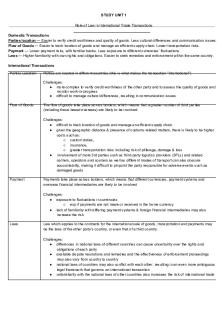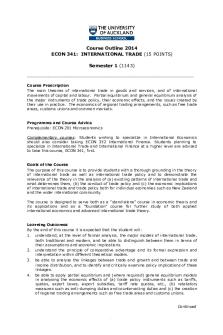Course Outline of International Trade PDF

| Title | Course Outline of International Trade |
|---|---|
| Author | Sophath Phon |
| Course | Macro Economics |
| Institution | Royal University of Law and Economics |
| Pages | 3 |
| File Size | 140.2 KB |
| File Type | |
| Total Downloads | 78 |
| Total Views | 176 |
Summary
Download Course Outline of International Trade PDF
Description
Course Outline 2014 ECON 341: INTERNATIONAL TRADE (15 POINTS) Semester 1 (1143) _______________________________________________________________________ Course Prescription The main theories of international trade in goods and services, and of international movements of capital and labour. Partial equilibrium and general equilibrium analysis of the major instruments of trade policy, their economic effects, and the issues created by their use in practice. The economics of regional trading arrangements, such as free trade areas, customs unions and common markets.
Programme and Course Advice Prerequisite: ECON 201 Microeconomics Complementary courses: Students wishing to specialize in International Economics should also consider taking ECON 352 International Finance. Students planning to specialize in International Trade and International Finance at a higher level are advised to take this course, ECON 341, first.
Goals of the Course The purpose of this course is to provide students with a thorough grounding in the theory of international trade as well as international trade policy and to demonstrate the relevance of the theory in the analysis of (a) existing patterns of international trade and what determines them, (b) the conduct of trade policy and (c) the economic implications of international trade and trade policy both for individual economies such as New Zealand and the wider international community. The course is designed to serve both as a "stand-alone" course in economic theory and its applications and as a "foundation" course for further study of both applied international economics and advanced international trade theory.
Learning Outcomes By the end of this course it is expected that the student will: 1.
2.
understand, at the level of formal analysis, the major models of international trade, both traditional and modern, and be able to distinguish between them in terms of their assumptions and economic implications. understand the principle of comparative advantage and its formal expression and interpretation within different theoretical models.
3.
be able to analyse the linkages between trade and growth and between trade and income distribution, and to identify and critically examine policy implications of these linkages.
4.
be able to apply partial equilibrium and (where required) general equilibrium models in analysing the economic effects of (a) trade policy instruments such as tariffs, quotas, export taxes, export subsidies, tariff rate quotas, etc., (b) retaliatory measures such as anti-dumping duties and countervailing duties and (c) the creation of regional trading arrangements such as free trade areas and customs unions.
Continued
2.
ECON 341 Course Outline 2014
Learning Outcomes continued 5.
be familiar with, and be able to critically analyse the main arguments for protection and conversely be able to critically evaluate the relevance and realism of arguments for free trade, taking into account the costs and benefits of trade policy measures on different sections of the community and the implications for the formulation of trade policy.
6.
be familiar with the major recent developments in the world trading system, and be able to critically analyse key issues raised both by the current round of WTO negotiations and by the spread of regional trading arrangements.
Content Outline (Provisional) Week 1: Week 3:
Introduction ; Ricardian Model Specific-Factors Model;
Week 4: Week 5:
Heckscher-Ohlin Model Heckscher-Ohlin Model (continued); Factor Movements
Week 6:
Increasing Returns to Scale and Imperfect Competition; Offshoring
Week 7:
Tariffs and Quotas under Perfect Competition; Effective Protection
Week 8: Week 9:
Tariffs and Quotas under Imperfect Competition; Role of the WTO Tariff Rate Quotas, Export Subsidies, Trade Remedies
Week 10: Trade Agreements Week 11: Trade Agreements: Trade and the Environment
Learning and Teaching This course will be taught in the first semester. Lectures are scheduled for Wednesday 4-6pm and Thursday 3-5pm. Note that the full two hours of lectures on each day will be utilised, but lectures will be held in 9 or 10 weeks only. Students should ensure that they are available to attend lectures at these times. Learning in this course is through lectures and personal study. Tutorials will be provided on Fridays at 9-10am, 10-11am, 11-12am, and 12-1pm. Students are encouraged to attend tutorials. There will be no tutorials in Week 2 (14 March), Week 6 (11 April) and Week 12 (6 June).
Teaching Staff Associate Professor Rob Scollay, room 653, 6th floor, Owen G. Glenn building, Telephone: 923 6910, email: [email protected]
Learning Resources Prescribed Text: Feenstra, Robert C. and Alan M. Taylor, 2011, International Trade, 2nd edition, Worth Publishers, ISBN 9781429206907. The textbook should (2008) edition of the are minor differences etc) will be posted on
be available at UBS and Vol. 1 bookshops. If you have the 1st textbook, you can still use it but will need to be aware that there from the 2nd edition. All course material (notes, tutorial questions Cecil.
Continued
3.
ECON 341 Course Outline 2014
Learning Resources continued Some Useful Websites: WTO, http://www.wto.org UNCTAD, http://www.unctad.org OECD, http://www.oecd.org Economics Resources, http://www.helsinki.fi/WebEc Ministry of Foreign Affairs and Trade, NZ, http://www.mft.govt.nz International Center for Trade and Sustainable Development, http://www.ictsd.org The World Bank, http://www.worldbank.org Paul Krugman’s (Princeton University) website, http://www.wws.princeton.edu/~pkrugman/ Alan Deardorff’s Glossary of International Economics Terms, http://wwwpersonal.umich.edu/~alandear/glossary
Assessment The final grade will be based on two components: Coursework (40%) and a Final 3-hour Examination (60%). Coursework consists of two compulsory Tests (each worth 15%) and one Assignment (worth 10%). Plussage does NOT apply. Tests will be held in the evening, on the following dates: Test 1: 6th May, covering material from Weeks 1-6 (short answers) Test 2: 4th June, covering material from Weeks 7-11 (multi-choice) The Assignment will be handed out on Friday 2nd May and will be due on Friday 23rd May at 4pm (hand in at assignment boxes on Level 0 of the Owen G. Glenn Building). Learning Outcome
Test 1
Assignment
Final Examination
1 2
X
X
X
X
X
X
3
X
Test 2
X
4
X
5
X
6
X
X
X X
X
________________________
X...
Similar Free PDFs

International Trade Law- Outline 1
- 46 Pages

International Trade Assignment 2
- 4 Pages

International Trade - Grade: B+
- 9 Pages

LOG305; International Trade LAW
- 39 Pages

PART 6 International Trade
- 5 Pages

International Trade Law
- 53 Pages

318 LMS - International Trade
- 2 Pages

Global International Trade Game
- 16 Pages

International Trade (Fall 18)
- 4 Pages

Summary International trade theory
- 40 Pages

International trade policy- 2122
- 78 Pages

International Trade Law
- 39 Pages
Popular Institutions
- Tinajero National High School - Annex
- Politeknik Caltex Riau
- Yokohama City University
- SGT University
- University of Al-Qadisiyah
- Divine Word College of Vigan
- Techniek College Rotterdam
- Universidade de Santiago
- Universiti Teknologi MARA Cawangan Johor Kampus Pasir Gudang
- Poltekkes Kemenkes Yogyakarta
- Baguio City National High School
- Colegio san marcos
- preparatoria uno
- Centro de Bachillerato Tecnológico Industrial y de Servicios No. 107
- Dalian Maritime University
- Quang Trung Secondary School
- Colegio Tecnológico en Informática
- Corporación Regional de Educación Superior
- Grupo CEDVA
- Dar Al Uloom University
- Centro de Estudios Preuniversitarios de la Universidad Nacional de Ingeniería
- 上智大学
- Aakash International School, Nuna Majara
- San Felipe Neri Catholic School
- Kang Chiao International School - New Taipei City
- Misamis Occidental National High School
- Institución Educativa Escuela Normal Juan Ladrilleros
- Kolehiyo ng Pantukan
- Batanes State College
- Instituto Continental
- Sekolah Menengah Kejuruan Kesehatan Kaltara (Tarakan)
- Colegio de La Inmaculada Concepcion - Cebu



